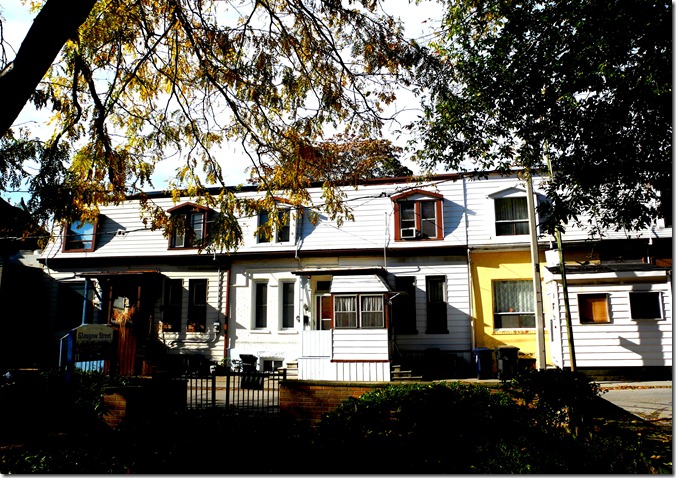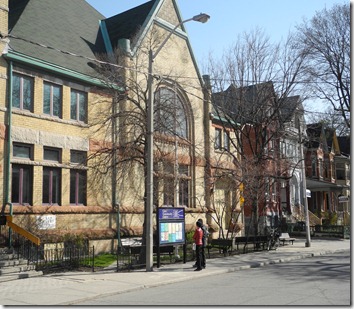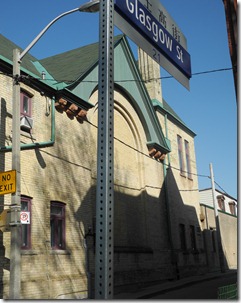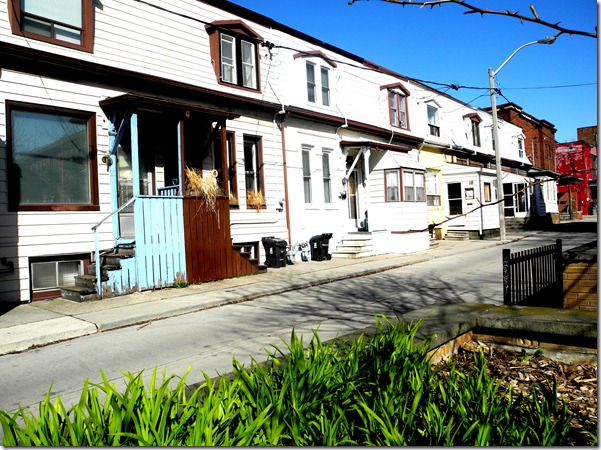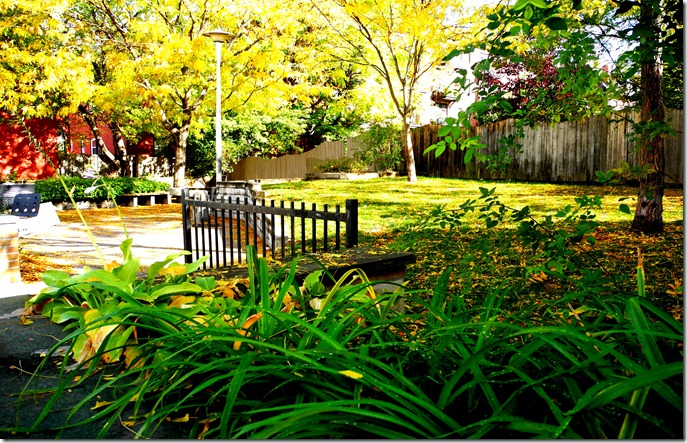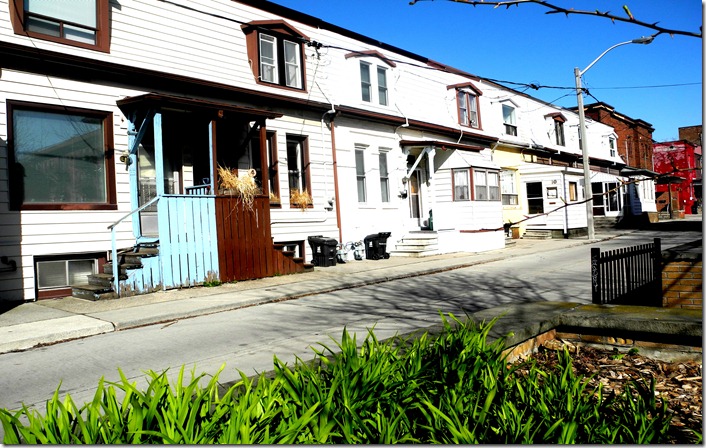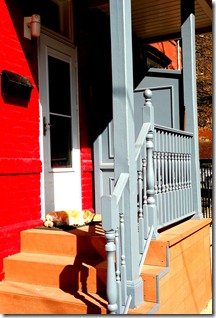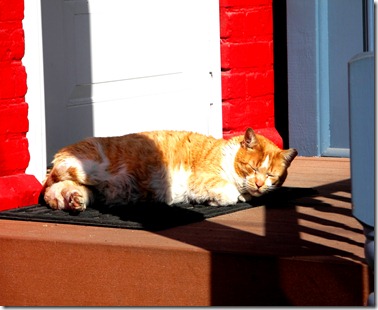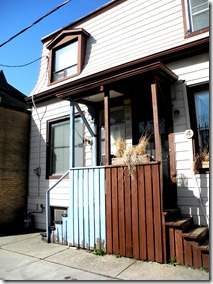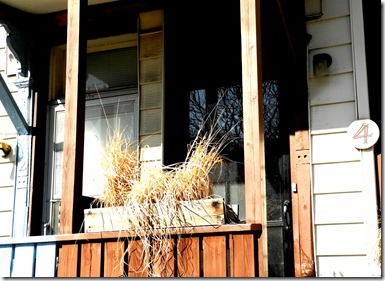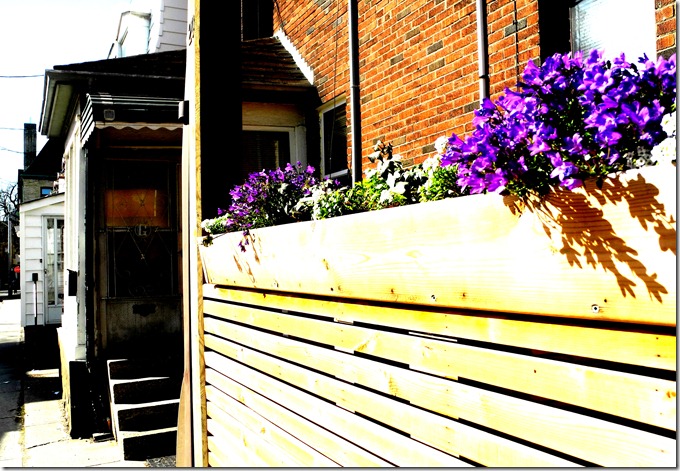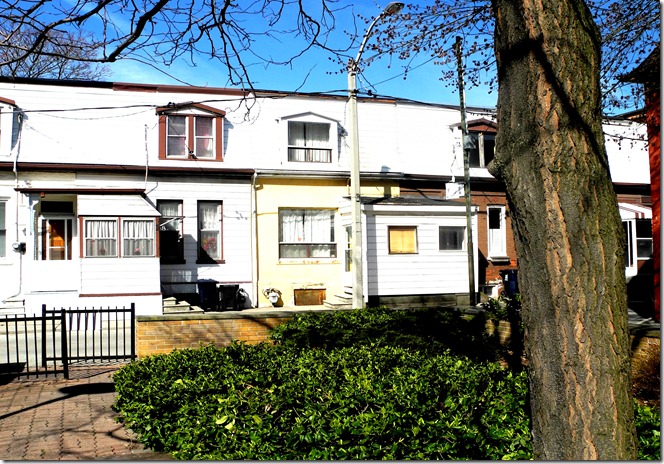Toronto has many architectural gems hidden in secluded locations where many people are unaware of their existence. The houses on Glasgow Street are among them. I first discovered this small street last autumn, while exploring the Spadina-College area of the city. To refer Glasgow Street as a street is perhaps a bit of an exaggeration, as in some respects it resembles a laneway. It can be entered from Cecil Street, which is one block south of College Street, east off Spadina. The entrance is narrow and easily over-looked, as it is beside the east wall of the Cecil Street Community Centre.
The small street that is today Glasgow Street, first appeared in the Toronto Directories in 1889. In that year it was named Spadina Place. In 1906, its name was changed to Glasgow Street, to avoid confusion with Spadina Avenue, as people were writing on envelopes mailed to Spadina Place—“Spadina Avenue Place.”
The photo on the left is of the Cecil Street Community Centre, on the south side of Cecil Street. The right-hand picture is of the sign beside the east wall of the Community Centre that indicates the location of Glasgow Street.
Similar to other small laneway-streets in the downtown area, Glasgow Street contains row houses built to accommodate workers that immigrated from the British Isles in the latter decades of the 19th century. When the first five houses appeared on the street in 1889, three of them were occupied by labourers, one who earned his living as a painter, and another as a piano maker. These small Second-Empire style houses provided reasonably priced accommodation for immigrant families. Second-Empire houses were very popular in Toronto during the 1870s. Their Mansard roofs, as opposed to peaked roofs, provided more interior space for large families. Unlike the Second-Empire row houses on Draper Street, which were built of brick, the dwellings on Glasgow Street were frame construction.
Today, the row house on Glasgow Street appear charming. Their location, tucked away from the noise and activity of the bustling downtown, is close to the downtown’s cultural and commercial activities. The tranquil atmosphere of this hidden street is a rarity in a city the size of Toronto. Many of the houses have small verandas, likely not present when the houses were first constructed, as the houses were designed to resemble those that the workers had left behind in the villages of Britain. In most instances, their former homes were flush with the stone walkways beside the narrow streets of the towns. At some point in time, small porches were added to some of the verandas to protect the front doors of the homes from the winter winds.
Another attractive feature of Glasgow Street is that even though it is only one block in length, it possesses its own small park, on the east side of the street. It is an intimate space, well maintained, with benches where residents are able to sit in warm weather to read, chat, or text. The above photo was taken in October of 2012.
This photo was taken on April 26, 2013, from the entrance to “Glasgow Park.”
The tranquility of Glasgow Street is not only appreciated by its residents. A contented feline sleeps undisturbed in the spring sunshine of an April morning.
Houses on Glasgow Street with Mansard roofs and small verandas. On one of them, the remnants of the last summer’s growth remain in the planter box on the railing.
A house on Glasgow Street with spring flowers in a planter box, and in the background, small porches on the row houses further south along the street .
Glasgow Street—a tiny part of the 19th century that remains in a city where so much of the past has been obliterated.
To view the Home Page for this blog: https://tayloronhistory.com/
To view other posts about Toronto’s unique streets.
Visiting one of Toronto’s best preserved 19th-century streets—Willcocks Street
Toronto’s Draper Street, a time-tunnel into the 19th century
Bulwer Street near Queen and Spadina—a street that has disappeared yet remains in view
To view other posts about Toronto’s past and its historic buildings:
The Occidental Building on the southeast corner of Spadina and Queen West.
https://tayloronhistory.com/2013/05/06/torontos-architectural-gems-building-at-queen-and-bathurst/
The historic Cameron House on Queen Street West
Toronto’s vanishing 19th-century store front.
The Art Deco bus terminal at Bay and Dundas Streets.
Photos of the surroundings of the CN Tower and and the St. Lawrence Market in 1977
The old Dominion Bank Building at King and Yonge Street
The Canada Life Building on University and Queen Street West.
Campbell House at the corner of Queen Street West and University Avenue
A study of Osgoode Hall
https://tayloronhistory.com/2012/04/12/enjoying-torontos-architectural-gems-osgoode-hall/
Toronto’s first City Hall, now a part of the St. Lawrence Market
The Black Bull Tavern at Queen and Soho Streets, established in 1822
History of the 1867 fence around Osgoode Hall on Queen Street West at York Street
Gathering around the radio as a child in the 1940s
The opening of the University Theatre on Bloor Street, west of Bay St.
https://tayloronhistory.com/2012/02/24/the-opening-of-torontos-university-theatre-on-bloor-street/
122 persons perish in the Noronic Disaster on Toronto’s waterfront in 1949
Historic Victoria Memorial Square where Toronto’s first cemetery was located, now hidden amid the Entertainment District
https://tayloronhistory.com/2012/01/09/victoria-square-in-torontos-entertainment-district-is-a-gem/
Visiting one of Toronto’s best preserved 19th-century streets-Willcocks Avenue
The 1930s Water Maintenance Building on Brant Street, north of St. Andrew’s Park
Toronto’s architectural gems-photos of the Old City from a book published by the city in 1912
Toronto’s architectural gems in 1912
https://tayloronhistory.com/2012/12/04/torontos-architectural-gems-in-1912/
Toronto’s architectural gems – the bank on the northeast corner of Queen West and Spadina
https://tayloronhistory.com/2012/12/02/torontos-architectural-gemsbank-at-spadina-and-queen-west/
Photos of the surroundings of the CN Tower and and the St. Lawrence Market in 1977
The St. Lawrence Hall on King Street
https://tayloronhistory.com/2012/04/28/enjoying-torontos-architectural-gems-the-st-lawrence-hall/
Toronto’s streetcars through the past decades
https://tayloronhistory.com/2012/03/26/memories-of-torontos-streetcars-of-yesteryear/
History of Trinity Bellwoods Park
https://tayloronhistory.com/2012/04/09/the-history-and-beauty-of-trinity-bellwood-park/
A history of Toronto’s famous ferry boats to the Toronto Islands
